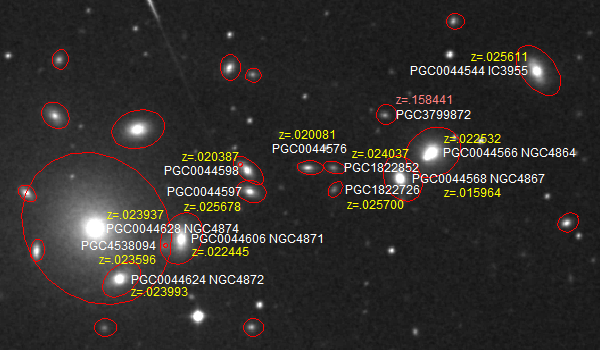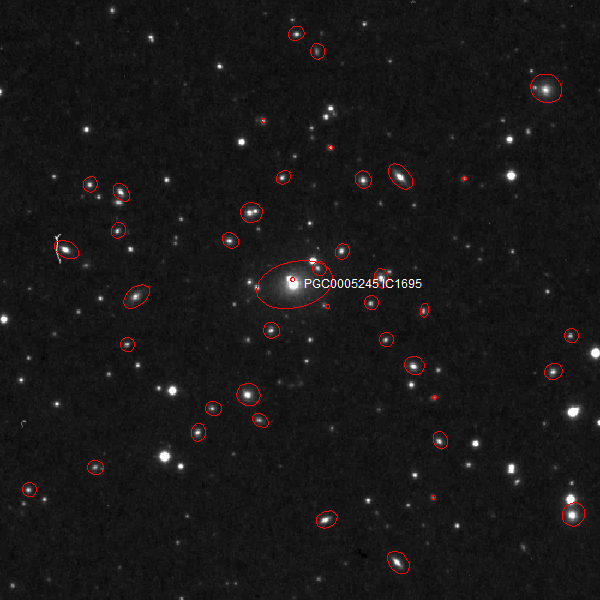I have already posted one example of a cluster of morphologically similar galaxies arranged in a distinct spiral shaped pattern. These Abell clusters are typically grouped around a large elliptical galaxy and turned at an angle in relation to the observer. Abell 1656 exhibits this same super spiral structure in spite of the fact that many of the small compact galaxies in this cluster appear to be separated by great distances, according to their redshifts. The following image was exported from version 2.76c of Patrick Chevalley’s sky chart program Cartes Du Ciel. The photograph is from the European Southern Observatory’s (ESO) first Digitized Sky Survey (DSS-1) overlaid with object outlines generated from the Principal Galaxies Catalog (PGC).

In the image are a large number of the aforementioned compact spiral galaxies extending outward from the elliptical galaxy NGC 4874 in three or more curved spiral arms. The image below, also exported from Cartes Du Ciel, is a close-up of one of these spiral arms. This photograph is from the ESO’s second Digitized Sky Survey (DSS-2) red channel while the object outlines are again generated from the PGC. In this image I have labeled in yellow the redshifts (z) for all the objects in the spiral arm including the center elliptical galaxy.

Most of these redshifts might seem to fall within a very narrow range of values. However when they are converted to distances it becomes obvious that the measurements vary significantly for such a tightly grouped set of objects. The smallest redshift value belongs to NGC 4867 at 0.015964 z. This places the galaxy at a supposed distance of over 282 million light years away when the redshift is converted to distance using a so-called Hubble Constant value of 55 (km/s)/Mpc. The highest redshift value belongs to PGC 1822726 which supposedly places it much further away at a distance of over 454 million light years using the same conversion method.
So here we have a group of small compact spiral galaxies packed so close together in a spiral arm configuration that a few of them appear to be almost touching; yet their redshifts indicate a maximum separation of over 171 million light years when viewed from Earth. There is also a galaxy in this spiral arm that appears to be the same size and shape as a couple of the other smaller galaxies in the arm but with a redshift of 0.158441 z. This value, which I’ve marked in red, supposedly places this galaxy at an incredible distance of over 2.7 billion light years away! This galaxy also shares the exact same morphology with several similarly sized galaxies in the other arms of the super spiral and yet is supposedly located almost ten times further away!
Once again scientists are faced with a big question: How can multiple objects be arranged in such tightly defined spiral shapes yet be separated from one another by such vast distances and only along one axis? And once again scientists can try to dismiss the findings as coincidence or dismiss the question altogether. But the evidence that extragalactic redshifts do not accurately represent distances and an associated expansion of the Universe will still continue to mount. I will of course continue to post examples of super spiral groups in this Report and I will continue to draw attention to the evidence. Questions and comments about any of these examples or the evidence are welcomed as always.
Shannon


 At first glance the redshift values do not appear to vary greatly from one another and seem to fall within a narrow range. However, when these values are converted to distances it immediately becomes apparent that there is something very wrong with the measurements. The most distant object among those labeled measures over 1.026 billion light years away when its redshift is converted using a so-called
At first glance the redshift values do not appear to vary greatly from one another and seem to fall within a narrow range. However, when these values are converted to distances it immediately becomes apparent that there is something very wrong with the measurements. The most distant object among those labeled measures over 1.026 billion light years away when its redshift is converted using a so-called